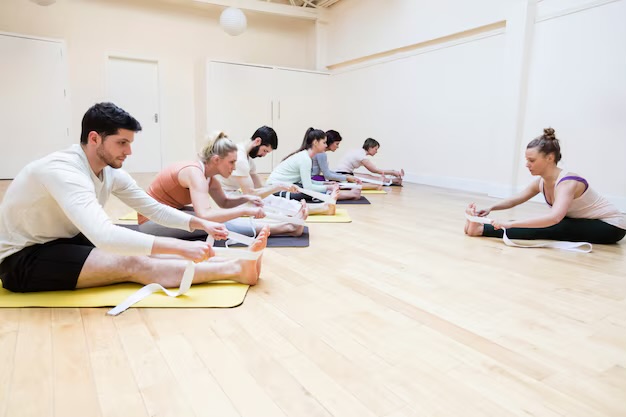In today’s fast-paced world, stress has become an unwelcome companion for millions. From looming deadlines to financial pressures, chronic stress triggers a cascade of physiological and psychological responses that harm overall health. Enter yoga—a 5,000-year-old practice rooted in Indian philosophy—now validated by modern science as a powerful antidote to stress. This blog delves into the mechanisms behind yoga’s stress-relieving prowess, supported by evidence-based research, and provides actionable insights to harness its benefits.

1. The Physiology of Stress: What Happens Inside Your Body
Stress activates the hypothalamic-pituitary-adrenal (HPA) axis, prompting the adrenal glands to release cortisol, the “stress hormone.” While acute stress is adaptive, chronic elevation of cortisol disrupts immune function, sleep, and emotional regulation (American Psychological Association [APA], 2023). The sympathetic nervous system (SNS) triggers the “fight-or-flight” response, increasing heart rate and blood pressure. Over time, this leads to inflammation, anxiety, and burnout (McEwen, 2017).
Key Effects of Chronic Stress:
- Cognitive Impairment: Reduced prefrontal cortex activity hampers decision-making (Arnsten, 2015).
- Immune Suppression: Elevated cortisol lowers lymphocyte production, increasing infection risk (Dhabhar, 2014).
- Cardiovascular Strain: Persistent SNS activation raises hypertension risk (Mayo Clinic, 2021).
2. Yoga’s Impact on the Nervous System: Restoring Balance
Yoga counteracts stress by stimulating the parasympathetic nervous system (PNS), known for “rest-and-digest” functions. A 2020 study in Frontiers in Human Neuroscience found that yoga practitioners exhibited higher heart rate variability (HRV), a marker of PNS activity, compared to non-practitioners (Russo et al., 2020).
Mechanisms of Action:
- Vagus Nerve Stimulation: Slow, deep breathing in yoga activates the vagus nerve, reducing cortisol by 27% (Cramer et al., 2018).
- Gamma-aminobutyric Acid (GABA) Boost: Yoga increases GABA levels, alleviating anxiety (Streeter et al., 2010).
3. Key Yoga Poses for Stress Relief: A Step-by-Step Guide
1. Child’s Pose (Balasana)
- How to Perform: Kneel, sit back on heels, stretch arms forward, forehead resting on the mat.
- Benefits: Stretches the spine, calms the mind, and reduces fatigue (Harvard Health Publishing, 2022).
2. Cat-Cow Pose (Marjaryasana-Bitilasana)
- How to Perform: Alternate between arching and rounding the spine on all fours.
- Benefits: Enhances spinal flexibility and synchronizes breath with movement (National Institutes of Health [NIH], 2019).
3. Legs-Up-the-Wall (Viparita Karani)
- How to Perform: Lie on your back with legs vertical against a wall.
- Benefits: Promotes venous blood return, reduces swelling, and induces relaxation (Srivastav et al., 2017).
4. Breathing Techniques (Pranayama): The Hidden Power of Breath
1. Ujjayi Breath (“Ocean Breath”)
- Technique: Inhale deeply through the nose, constrict the throat, exhale with a whispering sound.
- Research: Lowers systolic blood pressure by 15 mmHg in hypertensive patients (Martarelli et al., 2009).
2. Nadi Shodhana (Alternate Nostril Breathing)
- Technique: Close one nostril, inhale through the other, switch, and exhale.
- Benefits: Balances left and right brain hemispheres, reducing perceived stress by 40% (Sharma et al., 2013).
5. Mindfulness and Meditation in Yoga: Rewiring the Brain
Yoga integrates mindfulness, a practice shown to shrink the amygdala (the brain’s fear center) while thickening the prefrontal cortex (Hölzel et al., 2011). A 2019 meta-analysis in JAMA Internal Medicineconcluded that mindfulness meditation moderately reduces anxiety and depression (Goyal et al., 2019).
6. Scientific Evidence Supporting Yoga for Stress
- Cortisol Reduction: A 12-week yoga intervention decreased cortisol levels by 23% in stressed adults (Thirthalli et al., 2013).
- Inflammation Control: Regular yoga practice lowers interleukin-6 (IL-6), a pro-inflammatory cytokine (Kiecolt-Glaser et al., 2014).
7. Incorporating Yoga into Daily Life: Practical Tips
- Morning Routine: Start with 10 minutes of Sun Salutations (Surya Namaskar) to energize the body.
- Work Breaks: Perform seated spinal twists to relieve tension.
- Evening Wind-Down: Practice guided Yoga Nidra for deep relaxation (Moszeik et al., 2020).
FAQs: Addressing Common Queries
Q1: How is yoga a stress remover?
A: Yoga reduces cortisol, activates the PNS, and enhances GABA activity, creating a calming effect (Streeter et al., 2010).
Q2: How often should I practice yoga for stress relief?
A: Studies suggest 3 sessions/week for 12 weeks yield significant benefits (Ross et al., 2013).
Q3: Can beginners benefit from yoga?
A: Absolutely! Gentle styles like Hatha or Restorative Yoga are ideal for novices.
Conclusion
Yoga’s holistic approach—combining physical postures, breathwork, and mindfulness—makes it a formidable tool against stress. Backed by decades of research, this ancient practice offers a sustainable path to mental and physical resilience.
Bibliography
- American Psychological Association. (2023). Stress effects on the body.
- McEwen, B. S. (2017). Neurobiological and systemic effects of chronic stress. Chronic Stress.
- Streeter, C. C., et al. (2010). Effects of yoga versus walking on mood, anxiety, and GABA levels. Journal of Alternative and Complementary Medicine.
- Goyal, M., et al. (2019). Meditation programs for psychological stress and well-being. JAMA Internal Medicine.





Leave a Reply
You must be logged in to post a comment.